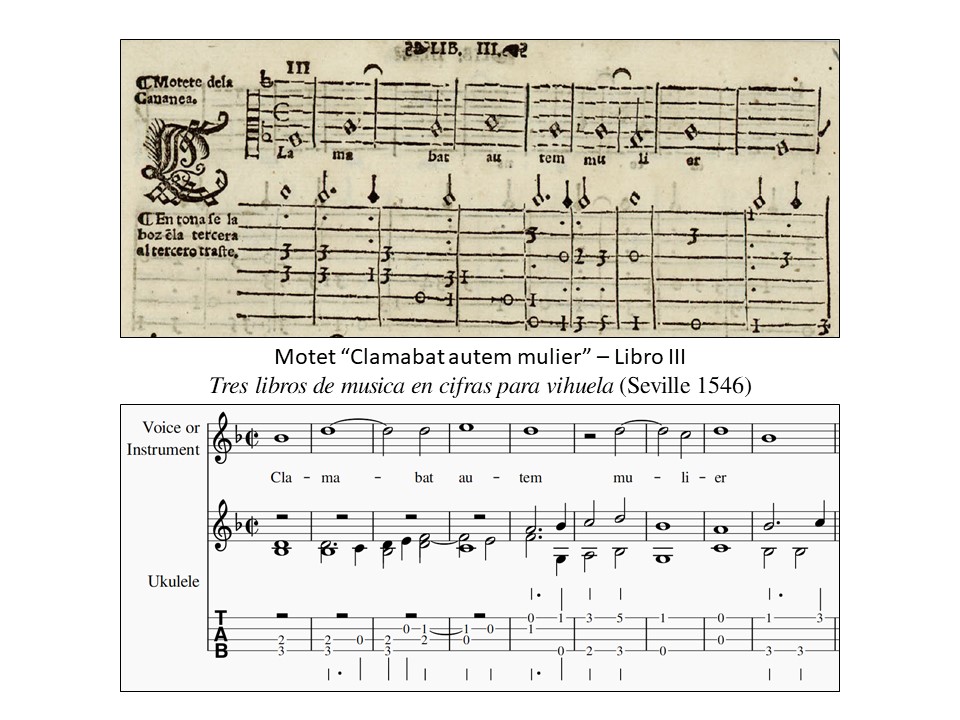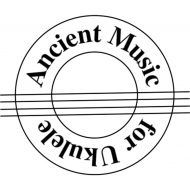All sources are Wikipedia.
Alonso Mudarra (ca 1510 – 1580) was a Spanish composer of the Renaissance, and also played the vihuela, a guitar-shaped string instrument. He was an innovative composer of instrumental music as well as songs, and was the composer of the earliest surviving music for the guitar.
Mudarra wrote numerous pieces for the vihuela and the four-course guitar, all contained in the collection Tres libros de musica en cifras para vihuela (“Three books of music in numbers for vihuela”), which he published on December 7, 1546 in Seville. These three books contain the first music ever published for the four-course guitar, which was then a relatively new instrument.
Compositions represented in this publication include fantasias, variations, tientos, pavanes and galliards, and songs. Modern listeners are probably most familiar with his Fantasia X, which has been a concert and recording mainstay for many years. The songs are in Latin, Spanish and Italian, and include romances, canciones (songs), villancicos (popular songs) and sonetos (sonnets) with the vihuela and voice written out on separate but aligned tabulatures. An innovation was the use of different signs for different tempos: slow, medium, and fast.
Arrangements in Books 1 to 5
All the selections are from Mudarra’s publication Tres libros de musica en cifras para vihuela (1546) as follows:
- Tres libros, Libro I
- Fantasias, Conde claros, Romanesca, Pavana, Gallarda
- Pieces written for Renaissance Gutiar (all are included in the book Mudarra & Fuenllana on the Ukulele from Ancient Music for Ukulele)
- Tres libros, Libro II
- Tientos and Fantasias (primer a octavo tono)
- Tres libros, Libro III
- Motetes, Romances, Canciones, Sonetos (en Castellano & Italiano), Versos en Latin, Villancicos, Psalmos with separate vihuela and voice tabulatures
Selection of Pieces for Inclusion in Book 1
This book of ukulele arrangements contains most of the vihuela music in Libro I of Tres libros.
Selection of Pieces for Inclusion in Book 2
This book of ukulele arrangements contains contains all eight tiento/fantasia pairs of pieces in Libro II of Tres libros.
Selection of Pieces for Inclusion in Book 3
This book of ukulele arrangements contains contains contains more fantasies in Libro I and II and several mass movements in Libro II of Tres libros.
Selection of Pieces for Inclusion in Book 4
This book of vocal/instrumental with ukulele arrangements contains motetes, romances and sonetos in Libro III of Tres libros.
Selection of Pieces for Inclusion in Book 5
This book of vocal/instrumental with ukulele arrangements contains canciones, villancicos and a verso in Libro III of Tres libros.
Selection of Pieces for Inclusion in Book 6
This book of vocal/instrumental with ukulele arrangements contains motetes, romances, sonetos, versos and psalmos in Libro III of Tres libros.
Notes on the Pieces
Fantasia
A fantasia or fantasie is a musical composition with its roots in the art of improvisation. The term was first applied to music during the 16th century, at first to refer to the imaginative musical “idea” rather than to a particular compositional genre. Its form and style consequently ranges from the freely improvisatory to the strictly contrapuntal, and also encompasses more or less standard sectional forms (i.e. it sometimes but doesn’t always follow the “rules”).
These should be played using varying tempos and styles to fit the mode of the music.
In Fantasia #10, the l.v. (“let vibrate”) notation means that the notes of the chord should be left ringing so that you can hear the entire chord after playing the notes individually.
NOTE: The numbering of the fantasies is for convenience only. No such numbering appears in Tres libros.
Conde claros
One of the earliest melodico-harmonic themes for variation appears in Spain in 1538 under the title “Conde Claros.” Wildly popular, it inspired variation sets by at least six composers in three countries during the sixteenth century.
The six bar phrases in the piece can be repeated as necessary with varying playing styles to form a longer performance.
Romanesca
Romanesca is a melodic-harmonic formula popular from the mid–16th to early–17th centuries that was used as an aria formula for singing poetry and as a subject for instrumental variation. The pattern, which is found in an endless collection of compositions labeled romanesca, is a descending descant formula within a chordal progression that has a bass which moves by 4ths. The formula was not to be viewed as a fixed tune, but as a framework over which elaborate ornamentation can occur It was most popular with Italian and Spanish composers of the Renaissance and early Baroque period. It was also used by vihuelistas including Alonso Mudarra.
Pavana
The pavane is a slow processional dance common in Europe during the 16th century. The music which accompanied it appears originally to have been fast or moderately fast but, like many other dances, became slower over time.
Gallarda
The galliard is a form of Renaissance dance and music popular all over Europe in the 16th century. The galliard is an athletic dance, characterised by leaps, jumps, hops and other similar figures.
Tiento
Tiento or tento is a musical genre originating in Spain in the mid-15th century. It is formally analogous to the fantasia (fantasy). The word derives from the Spanish verb tentar (meaning either to touch, to tempt or to attempt), and was originally applied to music for various instruments. The tento is formally extraordinarily diverse, more a set of guidelines than a rigid structural model. Nearly all tentos are imitative to some degree.
The chords are often strummed and the scale passages start slow, accelerate and then slow down at the end.
Missa
Kyrie, Benedictus, and Spiritu are movements from Missa (Masses). Most of the sacred music was written by Josquin des Pres, a French composer and considered the first master of the complex Renaissance style of polyphony which emerged during his lifetime. One piece is by Antoine de Févin, a Franco-Flemish composer, who was active at the same time.
The arrangements by Mudarra in Tres libros are tabulated without words or vocal parts, and are presented in Libro II which is organized by pitch (e.g. a series of pieces in “primer tono” or first pitch, second pitch, etc.). Beata Virgine is the Blessed Virgin. Ave Maria is a prayer to the Virgin Mary.
Motete
A motete or motet is mainly a vocal musical composition, of highly diverse form and style, from high medieval music to the present. The motet was one of the pre-eminent polyphonic forms of Renaissance music. According to Margaret Bent, “a piece of music in several parts with words” is as precise a definition of the motet as will serve from the 13th to the late 16th century and beyond.
Romance
A romance is a characteristic poem of the Spanish oral tradition. Romances reworked legends, fairy tales, and history to suit the readers’ and hearers’ tastes. They were very popular during the 15th century when compilations of romances were made in books called “romanceros”.
Soneto
The generic term soneto had no consistent meaning among Spanish vihuelists. It is certainly a setting of a poem, not necessarily a sonnet.
The term sonnet is derived from the Italian word sonetto (literally “little song”, derived from the Latin word sonus, meaning a sound). By the 13th century it signified a poem of fourteen lines that follows a very strict rhyme scheme and structure.
Cancione
A cancione or cancion is a popular song of Spain or Spanish America. Its roots lie in Spanish popular song forms, including tiranas, polos and boleros. In the Renaissance, the term was often used interchangeably with cantiga, cantar, canson, and sometimes villancico (see below). Cancion was the least specific term to cover all the popular, secular styles of vocal music of Spain at the time.
Villancico
Derived from medieval dance forms, the 15th century a villancico was a type of secular popular song sung in the vernacular and frequently associated with rustic themes. With the decline in popularity of the villancicos in the 20th century, the term became reduced to mean merely “Christmas carol”. The poetic form of the Spanish villancico was that of an estribillo (or refrain) and coplas (stanzas), with or without an introduction. While the exact order and number of repetitions varied, the most typical form was a loose ABA framework, often in triple meter.
Verso
This is a verse set to music. For example, “Beatus ille” is the beginning of Horace’s Epod II written in Latin by Paul Hofhaimer.
Psalmo (or Psalm)
The Mudarra psalms are the first instrumental fabordones, or for voice and instrument. A fabordone or fauxbourdon is a musical technique of harmonization, or chant, used in the music of the end of the Moyen Age and the debut of the Renaissance. The monotony of parallel cords favors the understanding of the text in Latin.
Notes on the Tabulature in Tres libros de musica en cifras para vihuela
Instrumental Notation
Italian tabulature was used by Spanish composers Mudarra, Fuenllana and others in the 16th century in music for the vihuela and Renaissance guitar. It almost looks like modern tabulation in that it uses numbers to represent the frets (zero for an open string, “1” for the first fret, “2” for the second fret, etc.) The duration of the notes are above the staff and look like our modern notes (whole notes, half notes, quarter notes), including dotted notes. Italian tabulature has the highest sounding string on the bottom line and the lowest sounding string on the top line (i.e. upside down from modern tabulation).
All of the arrangements are derived from music for the vihuela; however, it has been altered so that the 3rd string on the modern or Renaissance guitar or ukulele need not be lowered by a half tone (i.e. normal tuning is keep for your guitar or ukulele). Also, since the vihuela has 6 strings and the ukulele only has 4 strings, the bass notes have been changed while retaining the original harmonies whenever possible.
Vocal Notation
Mensural notation was used for the vocal parts, with the addition of bar lines and alignment of the bars with the instrumental accompaniment.

NOTE: See more details in the news post “Music with vocal / instrumental parts“.
